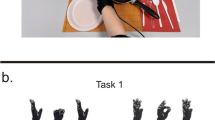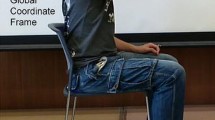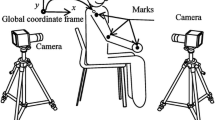Abstract
Planar arm trajectories are characterized by a segmentation of the hand velocity profile and by a coupling between shape and speed. The question addressed in this paper is whether such coupling, observed in two dimensions, still holds in three dimensions. This matter was investigated experimentally by recording three dimensional “aimless” movements of the arm, particularly three dimensional scribbles, and the answer suggested by the experimental data is that only the “bending” of the trajectory is coupled with speed, whereas the “twisting” is independent of speed. The same behaviour was also found to characterize a computational model of trajectory formation which is based on the spatial composition of chains of planar strokes, overlapped in time.
Similar content being viewed by others
References
Abend, W., Bizzi, E., Morasso, P.: Human arm trajectory formation. Brain105, 331–348 (1982)
Denier van der Gon, J.J., Thuring, J.Ph.: The guiding of human writing movements. Kybernetik2, 145–148 (1965)
Kots, Y.M., Syrovegin, A.M.: Fixed sets of invariants of interactions of the muscles of the two joints used in the execution of single voluntary movements. Biofisica11, 1061–1066 (1966)
Lacquaniti, F., Soechting, J.F.: Coordination of arm and wrist motion during a reaching task. J. Neurosci2, 399–408 (1982)
Morasso, P.: Spatial control of arm movements. Exp. Brain Res.42, 223–227 (1981)
Morasso, P., Mussa Ivaldi, F.A.: Trajectory formation and handwriting: a computational model. Biol. Cybern.45, 131–142 (1982)
Morasso, P., Mussa Ivaldi, F.A. Ruggiero, C.: How a discontinuous mechanism can produce continuous patterns in trajectory formation and handwriting Acta Psychol.54 (1983) (in press)
Morasso, P., Tagliasco, V.: Analysis of human movements: spatial localisation with multiple perspective views. Med. Biol. Eng. Comput.21, 74–82 (1983)
Morasso, P.: Coordination aspects of arm trajectory formation. Human Movem. Sci. (1983) (in press)
Prablanc, C., Echellier, J.F., Komillis, K., Jeanerod, M.: Optimal response of eye and hand motor systems in pointing at a visual target. Biol. Cybern.35, 113–124 (1981)
Rektorys, K. (ed.): Survey of applicable mathematics. Cambridge: MIT Press 1969
Teulings, H.L.H.M., Thomassen A.J.W.M.: Computer aided analysis of handwriting movements. Visible LanguageXIII3, 218–231 (1979)
Viviani, P., Terzuolo, C.A.: Space-time invariance in learned motor skills. In: Tutorials in motor behaviour: Stelmach, G.E., Requin, J. (eds.), pp. 525–533. Amsterdam: North-Holland 1980
Author information
Authors and Affiliations
Rights and permissions
About this article
Cite this article
Morasso, P. Three dimensional arm trajectories. Biol. Cybern. 48, 187–194 (1983). https://doi.org/10.1007/BF00318086
Received:
Issue Date:
DOI: https://doi.org/10.1007/BF00318086




